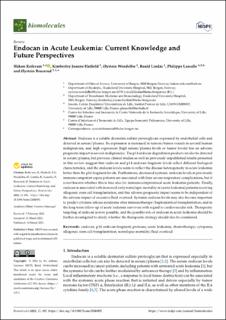| dc.contributor.author | Reikvam, Håkon | |
| dc.contributor.author | Hatfield, Kimberley Joanne | |
| dc.contributor.author | Wendelbo, Øystein | |
| dc.contributor.author | Lindås, Roald | |
| dc.contributor.author | Lasalle, Phillip | |
| dc.contributor.author | Bruserud, Øystein | |
| dc.date.accessioned | 2023-02-16T11:29:45Z | |
| dc.date.available | 2023-02-16T11:29:45Z | |
| dc.date.created | 2022-04-03T10:43:09Z | |
| dc.date.issued | 2022 | |
| dc.identifier.citation | Biomolecules. 2022, 12 (4), 1-22 | en_US |
| dc.identifier.issn | 2218-273X | |
| dc.identifier.uri | https://hdl.handle.net/11250/3051453 | |
| dc.description | This article is an open access article distributed under the terms and conditions of the Creative Commons Attribution (CC BY) license (https:// creativecommons.org/licenses/by/ 4.0/). | en_US |
| dc.description.abstract | Endocan is a soluble dermatan sulfate proteoglycan expressed by endothelial cells and detected in serum/plasma. Its expression is increased in tumors/tumor vessels in several human malignancies, and high expression (high serum/plasma levels or tumor levels) has an adverse prognostic impact in several malignancies. The p14 endocan degradation product can also be detected in serum/plasma, but previous clinical studies as well as previously unpublished results presented in this review suggest that endocan and p14 endocan fragment levels reflect different biological characteristics, and the endocan levels seem to reflect the disease heterogeneity in acute leukemia better than the p14 fragment levels. Furthermore, decreased systemic endocan levels in previously immunocompetent sepsis patients are associated with later severe respiratory complications, but it is not known whether this is true also for immunocompromised acute leukemia patients. Finally, endocan is associated with increased early nonrelapse mortality in (acute leukemia) patients receiving allogeneic stem cell transplantation, and this adverse prognostic impact seems to be independent of the adverse impact of excessive fluid overload. Systemic endocan levels may also become important to predict cytokine release syndrome after immunotherapy/haploidentical transplantation, and in the long-term follow-up of acute leukemia survivors with regard to cardiovascular risk. Therapeutic targeting of endocan is now possible, and the possible role of endocan in acute leukemia should be further investigated to clarify whether the therapeutic strategy should also be considered. | en_US |
| dc.language.iso | eng | en_US |
| dc.publisher | MDPI | en_US |
| dc.rights | Navngivelse 4.0 Internasjonal | * |
| dc.rights.uri | http://creativecommons.org/licenses/by/4.0/deed.no | * |
| dc.subject | fluid overload | en_US |
| dc.subject | nonrelapse mortality | en_US |
| dc.subject | allogeneic stem cell transplantation | en_US |
| dc.subject | cytopenia | en_US |
| dc.subject | chemotherapy | en_US |
| dc.subject | acute leukemia | en_US |
| dc.subject | protease | en_US |
| dc.subject | p14 endocan fragment | en_US |
| dc.subject | endocan | en_US |
| dc.title | Endocan in Acute Leukemia: Current knowledge and future perspectives | en_US |
| dc.type | Peer reviewed | en_US |
| dc.type | Journal article | en_US |
| dc.description.version | publishedVersion | en_US |
| dc.rights.holder | © 2022 by the Authors. Licensee MDPI, Basel, Switzerland. | en_US |
| dc.source.pagenumber | 1-22 | en_US |
| dc.source.volume | 12 | en_US |
| dc.source.journal | Biomolecules | en_US |
| dc.source.issue | 4 | en_US |
| dc.identifier.doi | 10.3390/biom12040492 | |
| dc.identifier.cristin | 2014843 | |
| dc.source.articlenumber | 492 | en_US |
| cristin.ispublished | true | |
| cristin.fulltext | original | |
| cristin.qualitycode | 1 | |

